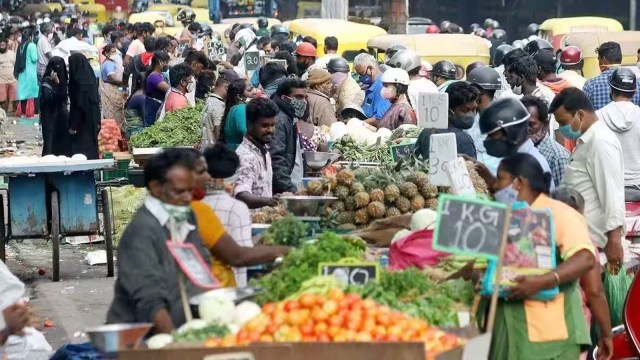Can be more patient to bring down inflation to 4%: RBI panel member
With retail inflation at 5 per cent now and an environment of greater economic stability, how fast should the Reserve Bank of India go in reining in inflation? There are differences of opinion in the Monetary Policy Committee of the central bank.
 The RBI has projected headline retail inflation at 5.4 per cent for 2023-24.
The RBI has projected headline retail inflation at 5.4 per cent for 2023-24. RBI’s Monetary Policy Committee member Jayanth R Varma is of the view that there is a need to be more patient when it comes to gliding inflation to the 4 per cent target, and this is the price to pay for avoiding a growth shock.
With retail inflation at 5 per cent now and an environment of greater economic stability, how fast should the Reserve Bank of India go in reining in inflation? There are differences of opinion in the Monetary Policy Committee of the central bank.
“I have been saying for quite some time now that while there is great urgency for bringing inflation well below the upper tolerance band, we can be more patient when it comes to gliding inflation to the target. A more rapid pace of reduction could impose an intolerable growth sacrifice. We should be willing to accept inflation between 4 per cent and 5 per cent for several quarters as the price of avoiding a growth shock,” Varma, Professor of Finance and Accounting, IIM Ahmedabad, told The Indian Express in an interview.
In its meeting on October 6, the MPC had retained the main policy instrument, repo rate, at 6.50 per cent and decided to stick to the stance of “withdrawal of accommodation”. Two weeks later on October 20, RBI Governor Shaktikanta Das said monetary policy must remain actively disinflationary to ensure that ongoing disinflation process progresses smoothly in the current situation.
Addressing the Kautilya Economic Conclave in New Delhi, Das said price stability and financial stability complement each other. In fact, price stability is an anchor for financial stability, but the trade-off between the two becomes a close call at times. “It has been our endeavour to manage these complementarities and trade-offs as efficiently as possible. While according priority to price stability keeping in mind the objective of growth, as mandated under the law, we treat financial stability as non-negotiable,” he said.
According to Varma, while there is great urgency for bringing inflation well below the upper tolerance band, “we can be more patient when it comes to gliding inflation to the target”. Headline retail inflation has moderated sharply to 5 per cent in September 2023 with correction in vegetable prices.
On October 6, while announcing a status quo the bi-monthly monetary policy, Das emphatically said the inflation target is 4 per cent and not 2 per cent to 6 per cent. “Our aim is to align inflation to the target on a durable basis, while supporting growth,” Das emphasised.
The RBI has projected headline retail inflation at 5.4 per cent for 2023-24. “As evident from our survey of September 2023, there is further progress on anchoring of inflation expectations which entered single digit zone for the first time since the COVID-19 pandemic,” Das said.
RBI Governor doesn’t see any issue on the growth front, stating that economic activity in India exhibits resilience on the back of strong domestic demand. “Real GDP growth for 2023-24 is projected at 6.5 per cent and India is poised to become the new growth engine of the world,” he said.
There’s also difference of opinion on withdrawal of accommodation, or loose monetary policy with higher liquidity in the system. Withdrawal of accommodation is expected to bring down liquidity and aid in bringing down inflation. When the MPC talks about “withdrawal of accommodation” it can refer only to increases in the repo rate which is within its mandate, and not to something that is outside the ambit of the MPC. As such, when meeting after meeting ends with a resolve to raise rates, but does not actually do so, that creates a dissonance between words and deeds, Varma said.
Varma says reduction in the repo rate need not wait for the 4 per cent inflation target. “Monetary policy acts with lags and must therefore be forward looking. What matters is that projected inflation falls close to 4 per cent on a durable basis and not that actual inflation does so. Second, if a real repo rate of 1 per cent is required to glide inflation to target, then the required nominal repo rate falls with falling inflation projections,” Varma said.
For example, if projected inflation falls durably below 4.5 per cent, then the current repo rate of 6.5 per cent would translate into a real rate of 2 per cent which would probably be excessive. There would then be a need to cut the repo rate to maintain the real rate at a reasonable level, he said.
On the ongoing conflict in the Middle East, Varma said there is no question that the conflicts there pose risks to the world economy. “What I find reassuring is that oil prices have remained range bound in the face of these conflicts. This is in my view suggestive of depressed global demand putting a lid on prices. Of course, a bigger flare up in the region that takes us back to 1973 would be a very different situation, but as of now there is ground for guarded optimism,” he said.





- 01
- 02
- 03
- 04
- 05


























